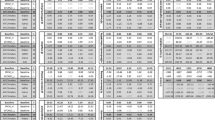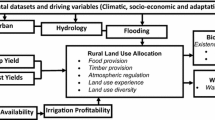Abstract
Understanding the importance of cross-sectoral implications of climate and socio-economic change in Scotland is essential for adaptation policy. This study explored the direct and indirect sectoral impacts of future change using the CLIMSAVE Integrated Assessment Platform. There is great spatial diversity in projected impacts across Scotland, and increasing uncertainty in the direction of change of impacts from the national to regional scale associated with climate uncertainty. Further uncertainty associated with socio-economic change results in 6 out of 13 indicators (artificial surfaces, biodiversity vulnerability, forest area, land-use intensity, irrigation usage and land-use diversity) with robust directions of change at the national scale and only three (artificial surfaces, forest area and irrigation usage) that are robust across all regions of Scotland. Complex interactions between socio-economic scenario assumptions (e.g. food imports, population and GDP), climatic suitability and agricultural productivity and profitability lead to significant national and regional changes in the distribution and extent of land cover types, with resultant cross-sectoral interactions with water, forestry and biodiversity. Consequently, stakeholders characterised robust adaptation policy options, within the CLIMSAVE participatory process, as those beneficial to society (and the country) in all scenarios, irrespective of the direction of change of the impacts. The integration in CLIMSAVE of a participatory scenario development process and an integrated participatory modelling framework has allowed the exploration of future uncertainty in a structured approach and better represented the importance of qualitative information and the social and institutional contexts within adaptation research.



Similar content being viewed by others
References
Alcamo J (2008) Environmental futures: the practice of environmental scenario analysis. Developments in integrated environmental assessment—volume 2. Elsevier, Amsterdam
Andersson L, Wilk J, Graham LP, Warburton M (2013) Design and test of a model-assisted participatory process for the formulation of a local climate adaptation plan. Climate Develop 5(3):217–228. doi:10.1080/17565529.2013.812955
Audsley E, Pearn KR, Harrison PA, Berry PM (2008) The impact of future socio-economic and climate changes on agricultural land use and the wider environment in East Anglia and North West England using a metamodel system. Clim Change 90:57–88. doi:10.1007/s10584-008-9450-9
Bormann H, Ahlhorn F, Klenke T (2012) Adaptation of water management to regional climate change in a coastal region—Hydrological change vs. community perception and strategies. J Hydrol 454:64–75. doi:10.1016/j.jhydrol.2012.05.063
Bradley SL, Milne GA, Shennan I, Edwards R (2011) An improved glacial isostatic adjustment model for the British Isles. J Quat Sci 26(5):541–552. doi:10.1002/jqs.1481
Brown I, Poggio L, Gimona A, Castellazzi M (2011) Climate change, drought risk and land capability for agriculture: implications for land use in Scotland. Reg Environ Chang 11(3):503–518. doi:10.1007/s10113-010-0163-z
Carmichael J, Tansey J, Robinson J (2004) An integrated assessment modelling tool. Glob Environ Chang 14:171–183. doi:10.1016/j.gloenvcha.2003.12.002
Carter TR, Jones RN, Lu X, Bhadwal S, Conde C, Mearns LO, O’Neill BC, Rounsevell MDA, Zurek MB (2007) New assessment methods and the characterisation of future conditions. In: Parry ML, Canziani OF, Palutikof JP, van der Linden PJ and Hanson CE (eds) Climate change 2007: impacts, adaptation and vulnerability. Contribution of Working Group II to the fourth assessment report of the intergovernmental panel on climate change. Cambridge University Press, Cambridge, pp 133–171
Cartwright A, Blignaut J, De Wit M, Goldberg K, Mander M, O’Donoghue S, Robert D (2013) Economics of climate change adaptation at the local scale under conditions of uncertainty and resource constraints: the case of Durban South Africa. Env Urban 25(1):139–156. doi:10.1177/0956247813477814
Gramberger M, Harrison PA, Jager J, Kok K, Libbrecht S, Maes M, Metzger M, Stuch B, Watson M (2013) Report on the third CLIMSAVE regional stakeholder workshop. http://www.climsave.eu/climsave/doc/Report_on_the_third_regional_workshop.pdf. Accessed 2 May 2014
Gramberger M, Zellmer K, Kok K, Metzger M (in press) Stakeholder Integrated Research (STIR): A new approach tested in climate change adaptation research. Clim Change
Hinkel J, Bisaro A (2014) Methodological choices in solution-oriented adaptation research: a diagnostic framework. doi:10.1007/s10113-014-0682-0
Harrison PA, Berry PM, Henriques C, Holman IP (2008) Impacts of socio-economic and climate change scenarios on wetlands: linking water resource and biodiversity meta-models. Clim Chang 90(1–2):113–139. doi:10.1007/s10584-008-9454-5
Harrison PA, Holman IP, Cojocaru G, Kok K, Kontogianni A, Metzger MJ, Gramberger M (2013) Combining qualitative and quantitative understanding for exploring cross-sectoral climate change impacts, adaptation and vulnerability in Europe. Reg Environ Chang 13(4):761–780. doi:10.1007/s10113-012-0361-y
Hibbard KA, Janetos AC (2013) The regional nature of global challenges: a need and strategy for integrated regional modelling. Clim Chang 118:565–577. doi:10.1007/s10584-012-0674-3
Holman IP, Harrison PA (eds) (2011) Report describing the development and validation of the sectoral meta-models for integration into the IA platform. CLIMSAVE Deliverable 2.2. http://www.climsave.eu/climsave/doc/Report_on_the_Meta-models.pdf. Accessed 13 March 2014
Holman IP, Nicholls RJ, Berry PM, Harrison PA, Audsley E, Shackley S, Rounsevell MDA (2005) A regional, multi-sectoral and integrated assessment of the impacts of climate and socio-economic change in the UK: II Results. Clim Chang 71:43–73. doi:10.1007/s10584-005-5956-6
Holman IP, Rounsevell MDA, Cojacaru G, Shackley S, McLachlan C, Audsley E, Berry PM, Fontaine C, Harrison PA, Henriques C, Mokrech M, Nicholls RJ, Pearn KR, Richards JA (2008) The concepts and development of a participatory regional integrated assessment tool. Clim Chang 90(1–2):5–30. doi:10.1007/s10584-008-9453-6
Holman IP, Cojocaru G, Harrison PA (eds) (2013) Guidance report describing the final version of the CLIMSAVE Integrated Assessment Platform. CLIMSAVE Deliverable 2.4. http://www.climsave.eu/climsave/doc/Report_on_the_Final_IA_Platform.pdf. Accessed 13 March 2014
Kebede AS, Dunford R, Audsley E, Harrison PA, Holman IP, Mokrech M, Nicholls RJ, Rickebusch S, Rounsevell MDA, Sabaté S, Sallaba F, Sanchez A, Savin C-M, Trnka M, Wimmer F (in press) The sensitivity of cross-sectoral impacts to climate and socio-economic drivers for key European sectors. Clim Change
Kok K, Gramberger M, Simon K-H, Jäger J, Omann I (2011) Report on the new methodology for scenario analysis, including guidelines for its implementation, and based on an analysis of past scenario exercises. CLIMSAVE Deliverable 3.1. http://www.climsave.eu/climsave/doc/Report_on_the_Scenario_Methodology.pdf. Accessed 24 March 2014
Kok K, Sendzimir J, Barlund I, Florke M, Gramberger M, Zellmer K, Stuch B, Holman I (2014) European participatory scenario development: strengthening the link between stories and models. Clim Change. doi:10.1007/s10584-014-1143-y
MA [Millennium Ecosystem Assessment] (2005) Ecosystems and human well-being: general synthesis. Island Press, Washington
Maslin M (2013) Cascading uncertainty in climate change models and its implications for policy. Geogr J 179(3):264–271. doi:10.1111/j.1475-4959.2012.00494.x
Mokrech M, Nicholls RJ, Richards JA, Henriques C, Holman IP, Shackley S (2008) Regional impact assessment of flooding under future climate and socio-economic scenarios for East Anglia and North West England. Clim Chang 90(1–2):31–55. doi:10.1007/s10584-008-9449-2
Murphy JM, Sexton DMH, Jenkins GJ, Boorman PM, Booth BBB, Brown CC, Clark RT, Collins M, Harris GR, Kendon EJ, Betts RA, Brown SJ, Howard TP, Humphrey KA, McCarthy MP, McDonald RE, Stephens A, Wallace C, Warren R, Wilby R, Wood RA (2009) UK climate projections science report: climate change projections. Met Office Hadley Centre, Exeter. http://ukclimateprojections.metoffice.gov.uk/media.jsp?mediaid=87893&filetype=pdf. Accessed 8 May 2014
Panagos P, Van Liedekerke M, Jones A, Montanarella L (2012) European Soil Data Centre (ESDAC): response to European policy support and public data requirements. Land Use Policy 29(2):329–338. doi:10.1016/j.landusepol.2011.07.003
Rounsevell MDA, Reay DS (2009) Land use and climate change in the UK. Land Use Policy 26S:S160–S169. doi:10.1016/j.landusepol.2009.09.007
Rounsevell MDA, Reginster I, Araújo MB, Carter TR, Dendoncker N, Ewert F, House JI, Kankaanpää S, Leemans R, Metzger MJ, Schmit C, Smith P, Tuck G (2006) A coherent set of future land use change scenarios for Europe. Agric Ecosyst Environ 114:57–68. doi:10.1016/j.agee.2005.11.027
Salter J, Robinson J, Wiek A (2010) Participatory methods of integrated assessment—a review. WIREs Clim Chang 1:697–717. doi:10.1002/wcc.73
Scottish Government (2009) Scotland’s climate change adaptation framework. Scottish Government, Edinburgh. http://www.scotland.gov.uk/Resource/Doc/295110/0091310.pdf. Accessed 8 May 2014
Scottish Government (2013) Draft Scottish climate change adaptation programme required by section 53 of climate change (Scotland) Act 2009. Scottish Government, Edinburgh. http://www.scotland.gov.uk/Resource/0042/00426516.pdf. Accessed 24 March 2014
Skourtos M, Tourkolias Ch, Kontogianni A, Damigos D, Harrison P, Berry P (2014) Internalizing cross-sectoral effects into cost-effectiveness adaptation analysis. Clim Change. doi 10.1007/s10584-014-1168-2
Trivedi MR, Morecroft MD, Berry PM, Dawson TP (2008) Potential effects of climate change on plant communities in three montane nature reserves in Scotland UK. Biolog Conserv 141(6):1665–1675. doi:10.1016/j.biocon.2008.04.008
Wack P (1985) Scenarios: uncharted waters ahead. Harv Bus Rev 5:72–89
Acknowledgments
The research leading to these results has received funding from the European Commission Seventh Framework Programme under Grant Agreement No. 244031 (The CLIMSAVE Project; Climate change integrated assessment methodology for cross-sectoral adaptation and vulnerability in Europe; www.climsave.eu). CLIMSAVE is an endorsed project of the Global Land Project of the IGBP. The authors would like to thank all CLIMSAVE partners for their contributions to many productive discussions related to the content of this paper. The authors are also grateful to all stakeholders who participated in the project workshops and kindly offered their valuable input.
Author information
Authors and Affiliations
Corresponding author
Electronic supplementary material
Below is the link to the electronic supplementary material.
Rights and permissions
About this article
Cite this article
Holman, I.P., Harrison, P.A. & Metzger, M.J. Cross-sectoral impacts of climate and socio-economic change in Scotland: implications for adaptation policy. Reg Environ Change 16, 97–109 (2016). https://doi.org/10.1007/s10113-014-0679-8
Received:
Accepted:
Published:
Issue Date:
DOI: https://doi.org/10.1007/s10113-014-0679-8




